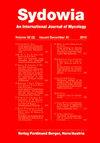Untersuchungen über die Gattung Discostroma Clements(Ascomycetes)
IF 1.2
4区 生物学
Q4 MYCOLOGY
引用次数: 19
Abstract
The systematical relations within a group of genera of Amphisphaeriaceae are shown by using the apical structure of the ascus and conidial forms as criteria. The genus Discostroma with the genera Seimatosporium and Sporocadus, which occur as its conidial states, was examined more intensely. In all eight species with Rosa, Ribes, Gornus and Epilobium hosts are involved. The identity of these species with already known species of the Fungi Imperfecti is shown using cultural experiments. An exception is D. saccardoana, for which only the perfect state was found in nature. Four new species are described: D. sanguineae on Cornus species and D. polymorpha, D. canina, and D. rosae on Rosa species. Of Seimatosporium hysterioides only the imperfect state is described, whereas the perfect state is not known. The occurence of filamentous appendages as suitable systematic criterium was examined. It is shown that the genus Sporocadus is well defined by the absence of appendages, whereas in Seimatosporium species the number of appendages varies considerably.探索发现者导弹属
以子囊和分生孢子的顶端结构为标准,揭示了水仙科一属间的系统关系。disstroma属与Seimatosporium属和Sporocadus属发生在其分生孢子状态,对其进行了更深入的研究。在所有与蔷薇属有关的8个物种中,涉及Ribes, Gornus和Epilobium宿主。这些物种与已知的真菌不完美种的身份是通过培养实验来证明的。一个例外是D. saccardoana,它在自然界中只有完美的状态。报告了4个新种:山茱萸上的D. sanguineae和玫瑰上的D. polymorpha、D. canina和D. rosae。迟滞半球形孢子只描述了不完全状态,而不知道完全状态。检查了丝状附属物的出现作为合适的系统标准。结果表明,Sporocadus属以其没有附属物而被很好地定义,而Seimatosporium种的附属物数量变化很大。
本文章由计算机程序翻译,如有差异,请以英文原文为准。
求助全文
约1分钟内获得全文
求助全文
来源期刊

Sydowia
生物-真菌学
CiteScore
3.30
自引率
10.00%
发文量
0
审稿时长
>12 weeks
期刊介绍:
Sydowia publishes reports of original research relevant to fungal taxonomy, systematics, evolution, structure, development, ecology, pathology (plants, animals, humans), and biotechnological applications. Reviews are published in areas of particular interest and current importance, but authors should consult the Editor before submitting a review manuscript. One volume of the journal, comprising two issues, is published each year. The official journal language is English. Submission of a manuscript to the Executive Editor implies that the results have not been previously published or simultaneously submitted to any other scientific journal, except as an abstract. When the authors are in doubt as to the suitability of their papers for Sydowia, the Editor of the journal should be consulted before submission of the manuscript.
All authors of a manuscript must have agreed to its submission and are responsible for its content. An author is one who has substantially contributed to the overall design and execution of the experiments. Individuals who supplied materials or critiqued the paper may be recognised in the acknowledgement section.
 求助内容:
求助内容: 应助结果提醒方式:
应助结果提醒方式:


